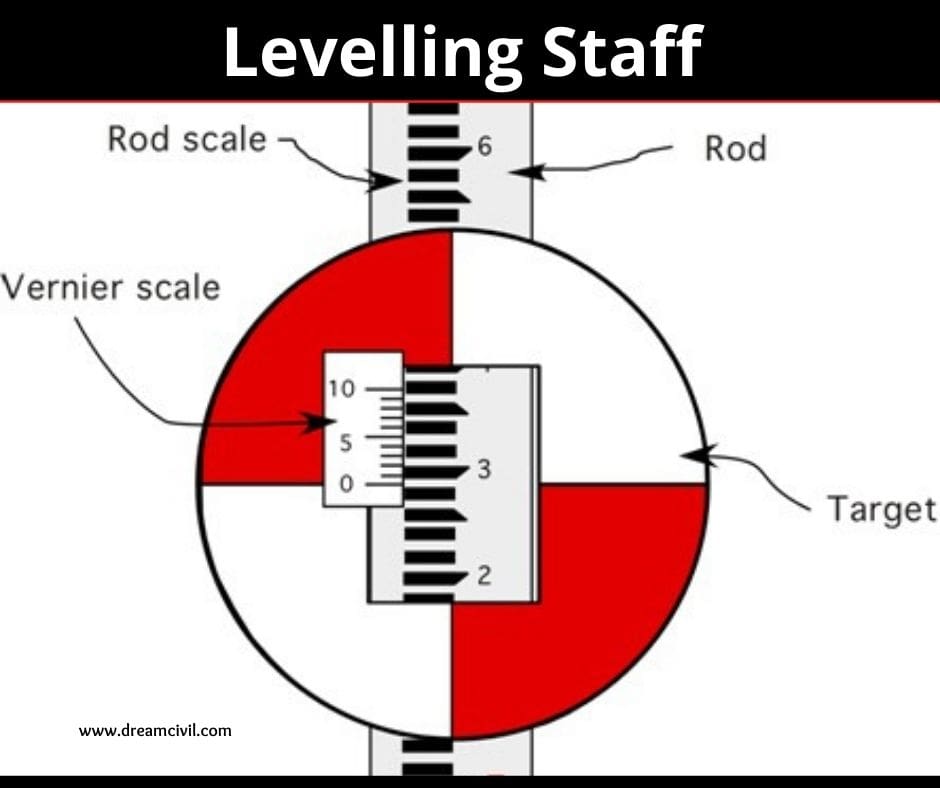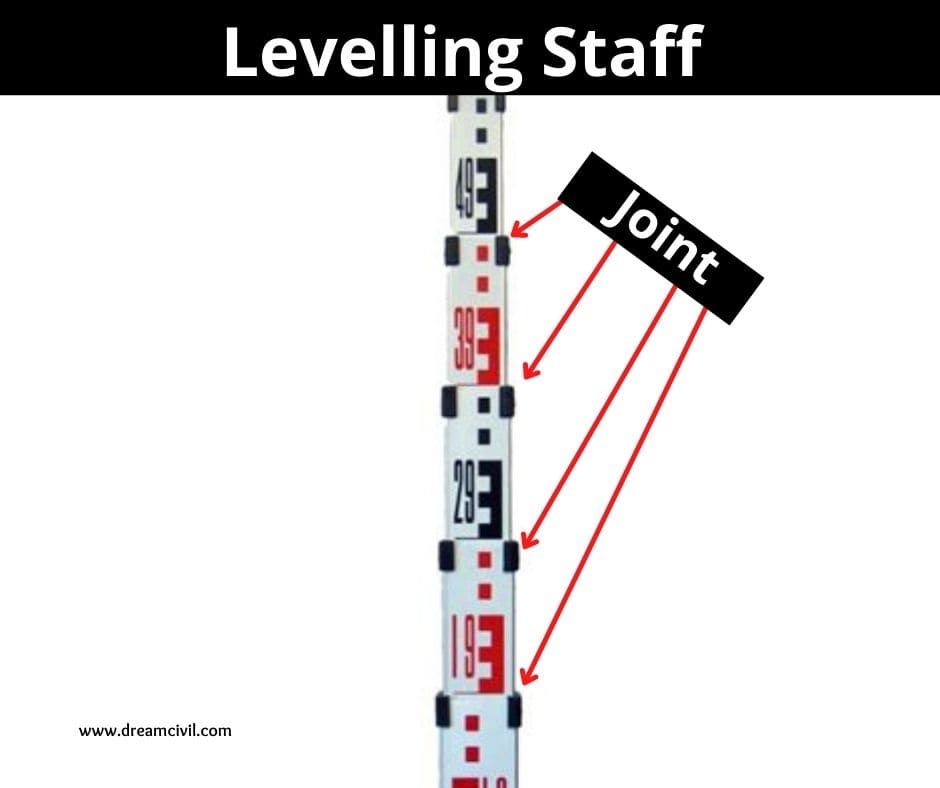Table of Contents
Leveling Staff is an instrument that is required to determine the difference in height between two different points.
Leveling Staff is also known as the stiff rod, Levelling rod, and self-reading staff, as the staff readings may be measured directly by the instrument man from the leveling instrument.
The metric system leveling staff is 4 meters long and prepared into two pieces of 2-meter length each. This is light, more suitable to
handle, and facilitates taking readings with higher accuracy than the telescopic type. The width and thickness of the Level staff are kept at 75 mm and 18 mm.
The staff is made of well-seasoned cypress, blue pine, or deodar wood free from defects such as knots, cracks, shakes, insect attacks, etc.
Leveling staff is found in the market of aluminum. Regarding quality, the Aluminum staff is considered the best and most accurate one.

1. Joint on Levelling Staff
A folding joint is kept to attach the two pieces together with a locking device at the back.
The joints are kept such that:
a. Two pieces may be easily detached from one another when required to facilitate easy handling and manipulation
b. Staff may be folded to a length of 2 meters
c. When the two pieces are kept together, the staff is completely rigid at the joint and perfectly straight.
Brass caps are kept at the bottom and the top of the staff. A cast-iron ground plate is attached to the staff, which may be utilized as a ground plate.
The ground plate has a semi-circular hole at the center such that the same may be placed on the bottom of the staff with a brass pin.

A circular bubble of 25 minutes of sensitivity is attached at the back of the staff to facilitate holding the staff vertically.
The bubble is 12 mm in diameter, 6 mm in height, suitably cased, and fixed with rust-proof brass screws at a convenient height.
Necessary fittings are kept for a plummet to test and correct the back bubble. The weight of the staff with all the fittings is not more than 6.5 kg. 1 meter is parted into 200 divisions of 5 mm each.
The graduations provide the distances exactly from the bottom brass cap of each length and are regular from one length to the other.
The whole number of meters is adjusted on the right side with red figures of 35 mm height.
The bottom of each graduation is at a distance of 5 mm from the increasing whole number of meters.
The bottom of the “0” meter division is 5 mm from the bottom of the staff, and the bottom of the “1” meter division is at a distance of 5 mm after 1 meter is completely over.
The figures indicating each decimeter are placed on the left side with black figures.
A red mark of 70 mm width and 5 mm thickness is provided at each decimeter.
The corresponding decimeter is done at the top of the red mark, and from there the next decimeter is taken.
The decimeter length is divided into 20 parts one black and one white space each of 5 mm thickness.
Thus the least count of staff that can be read is 5 mm. The graduations on the staff are marked to an accuracy of ±1 mm.
2. Taking Staff Readings
The steps for taking staff readings are as follows:
a. The instrument is placed on the ground and carefully leveled.
b. The staff is kept vertically over the staff station.
c. The telescope is adjusted towards the staff by the instrument man, and it is aimed by utilizing the focusing screw. The telescope is adjusted till the staff is kept between the vertical hairs of the diaphragm.
d. If the bubble on the theodolite is not at the center, the same is centered with the help of foot screws. The readings may now be taken.
The staff reading is the graduation on the staff at which the horizontal hair is shown to cut the leveling staff.
A staff reading consists of 4 digits. The first digit represents the whole number of meters, the second digit represents decimeters and the third, and fourth digits represent millimeters.
Thus if we say that a staff reading is 2.175, it means up to the division at which the horizontal cross-hair appears to cut the staff, 2 meters, 1 decimeter, and 75 mm have passed (75 mm means 15 spaces on the staff).
When the staff is seen through the theodolite, it appears upturn.
Therefore, the staff when held on the ground should be read from above downwards (and not from below upwards).
3. References1. Content Filter & Authenticity Checking Team, Dream Civil International (Our team checks every content & detail to maintain quality.) |
| Read Also: Errors in Levelling |

